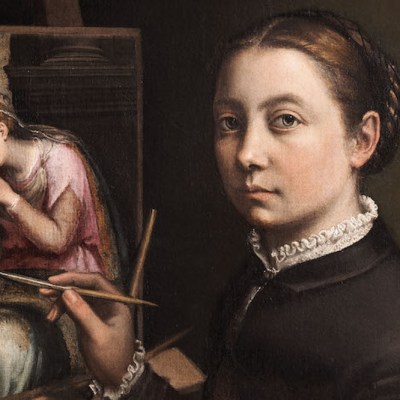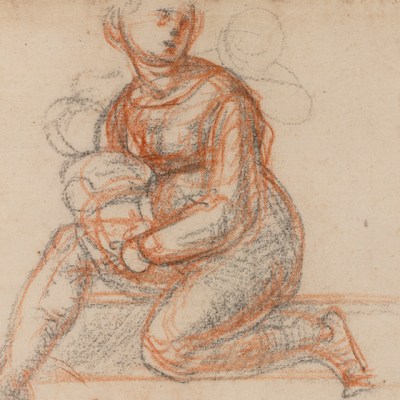On the morning of Saturday 14 December aficionados of Renaissance art gathered alongside local dignitaries inside the modest church of Santi Giuseppe e Lucia in the sleepy Tuscan hamlet of Montaione, some 50 miles south-west of Florence. The occasion was the return and public presentation of one of the church’s altarpieces – a Madonna of the Rosary depicting the Virgin and Child distributing rosary beads to Saints Dominic and Catherine of Siena – after its recent conservation. The picture had been displayed there at least since 1875 (and possibly much longer) over a side altar, untroubled by connoisseurs or scholars, until 2016 when the Uffizi curator Fausta Navarro identified it as a hitherto unrecognised and undocumented work by Suor Plautilla Nelli (d. 1588), often called the first female painter of Florence. Vasari called her ‘la prima’ and she is certainly the earliest woman artist in the city for whom a coherent body of work survives. The unveiling of the Montaione picture completes a programme of events over the past 12 months celebrating 500 years since Nelli’s birth, dated by most experts to the early weeks of 1524 (she was baptised on 29 January). The marking of her quincentenary consolidates the growth in interest in Suor Plautilla over the past quarter century, which has catapulted her from obscurity to a leading role (alongside Sofonisba Anguissola, Lavinia Fontana and Artemisia Gentileschi) in a still emerging narrative of female artists in Renaissance Italy.
Virgin of the Rosary with Saints Dominic and Catherine (c. 1580), Suor Plautilla Nelli. Santi Giuseppe e Lucia, Montaione. Photo: Artemisia Gold
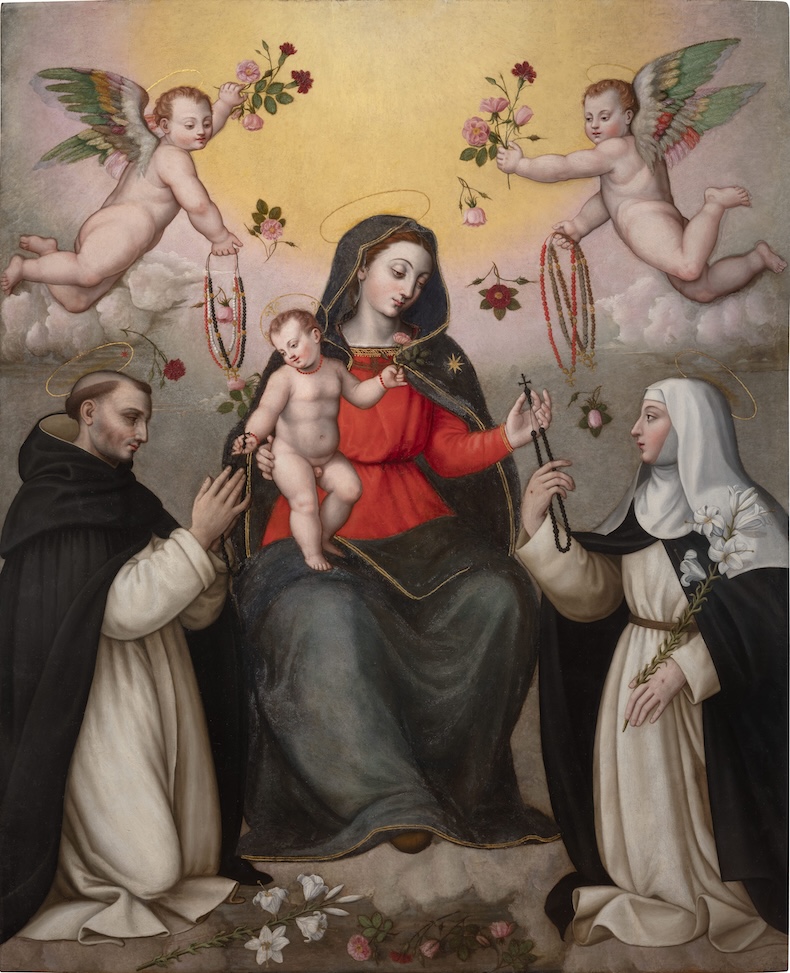
A Dominican nun whose painting career unfolded within the walls of her Florentine convent over five decades after she took her vows at the age of 14 in 1538, Plautilla was ignored by specialists until relatively recently. Modern scholarship on Nelli began with a pioneering conference in 1998 convened by the American art historian Jonathan Nelson. Attention then snowballed after the millennium, culminating in a monographic exhibition at the Uffizi in 2017 – the first that the gallery had ever dedicated to a female artist – and the completion in 2019 of a conservation campaign on her largest surviving painting, the 7 x 2 metre canvas of the Last Supper now displayed at Santa Maria Novella. Careful analysis of potential attributions and patient archival research has greatly expanded the number of works associated with Nelli and her workshop, added to what we know about her life and enhanced our understanding of the convent of Santa Caterina da Siena (also known as Santa Caterina in Cafaggio) in Florence where she practised her art and served three terms as prioress.
Scholarship on Nelli and conservation work on her surviving works have been sponsored and promoted, first, by the not-for-profit foundation Advancing Women Artists (AWA), then, after the death of its inspirational founder Jane Fortune in 2018, by the charity Artemesia Gold CIC. As well as funding the restoration of the Montaione altarpiece, Artemesia Gold organised a series of events over the course of 2024, including conferences on Suor Plautilla at Santa Maria Novella in March and at the Museo di San Marco in June.
Last Supper (c. 1560s; detail), Plautilla Nelli. Museo di Santa Maria Novella, Florence. Photo: Rabatti & Domingie; courtesy Advancing Women Artists

Plautilla’s works are now significantly more visible in the Museo di San Marco thanks to the transfer in 2022 of the three oil-on-panel lunettes of the Crucifixion with Symbols of the Passion, Saint Dominic Receiving the Rosary and the Vision of Saint Catherine from the Cenacolo di Andrea del Sarto at San Salvi, after their restoration funded by AWA and undertaken by Rossella Lari (lead conservator on almost all of the recent Nelli projects, including the Last Supper and the Montaione altarpiece). Nelli painted these lunettes in and for her convent of Santa Caterina, no longer extant but once located across the square from San Marco. While San Marco was a male Dominican house rather than a nunnery, it is a fitting context for Suor Plautilla’s work: the sisters of Santa Caterina were under the spiritual rule of the neighbouring friars and were strongly influenced by the reform programme and subsequent cult of San Marco’s firebrand preacher Girolamo Savonarola, burnt at the stake for heresy in 1498. In addition to the lunettes and choir books illuminated by Plautilla, the visitor to the Museo di San Marco can admire her Lamentation altarpiece alongside works by Fra Bartolommeo and other artists of the ‘Scuola di San Marco’ in the new picture hang of the grand refectory inaugurated on 1 October 2024.
The refreshed display at San Marco includes another picture by Nelli transferred from San Salvi, one of the series of images she and her workshop produced of her contemporary, the Dominican holy woman Caterina de’ Ricci (1522–90), portrayed in the guise of the medieval Dominican saint Catherine of Siena. This sequence of pictures, produced with the help of cartoons, was reconstructed and attributed for the first time to Nelli in the Uffizi show in 2017. Here Plautilla left the identity of the subject purposefully ambiguous, inviting the viewer to identify the still-living Caterina de’ Ricci with her sainted predecessor, Catherine of Siena. The locations and provenances of some of the other surviving copies – in Prato, Siena and Perugia – suggests that the series was systematically disseminated to Dominican communities from Suor Plautilla’s workshop at Santa Caterina.
With the revamped display at San Marco alongside the Last Supper in the refectory at Santa Maria Novella, Nelli’s works – most of them freshly restored – are more visible to the public than they have ever been. As well as foregrounding Suor Plautilla’s known works, the quincentenary programme has presented hitherto unrecognised paintings. The Montaione picture can be added to a small number of surviving or documented altarpieces by Nelli, and the circumstances of its commission are the subject of ongoing research. Concurrently with the Montaione project, the Istituto Lorenzo de’ Medici and Artemisia Gold have also conserved a much smaller panel attributed to Nelli and her workshop depicting the Virgin and Child with Saints Dominic, Agnes and Catherine of Siena. At the Museo di San Marco in June, leading Nelli expert Catherine Turrill Lupi explained how the new picture can be related to a series of other small-scale devotional images, and in particular to the Virgin and Child with Saints Dominic and Catherine of Siena that has been in the Catharijneconvent museum in Utrecht since the 19th century. The Utrecht painting was purchased in Italy before 1842 by the German collector Johann Anton Ramboux as by ‘Suor Plautilla Fiorentina’, and the distant view of the city and Brunelleschi’s dome confirm a Florentine setting. Like the newly discovered picture, the Utrecht painting foregrounds Dominican saints, suggesting that it was produced for a patron within the order’s orbit.
The Utrecht panel was first linked to Nelli by Turrill Lupi in 2017 and since then – as the scholar herself has phrased it – the ‘doors have opened’, with a group of related works coming to light in private hands and at auction. Turrill Lupi has connected further devotional images now in private collections to the newly conserved image and the Utrecht panel. Furthermore, she has demonstrated convincingly how these paintings incorporate features derived from works by Fra Bartolommeo and his close followers Fra Paolino da Pistoia and Antonio del Ceraiolo. In some cases these passages may reflect direct knowledge of paintings accessible to the nuns at Santa Caterina – like Fra Paolino’s and Ceraiolo’s altarpieces for their nunnery church – but in other instances the debts must be via the substantial cache of drawings by Fra Bartolommeo that seem to have been bequeathed by Fra Paolino to the nuns of Santa Caterina at his death in 1547 – a corpus of 883 sheets, around half of which later found their way to the Museum Boijmans van Beuningen in Rotterdam.
Virgin and Child with Saints Dominic, Agnes and Catherine of Siena (undated), Suor Plautilla Nelli and workshop. Private Collection. Photo: Artemisia Gold

Turrill Lupi’s research cements the association of this group of paintings with Santa Caterina and suggests the substantial production of devotional images of the Virgin and Child and saints at the convent. Further examples are likely to come to light; one recently appeared at auction in Florence at Pandolfini Casa d’Aste in March with a direct attribution to Plautilla Nelli, reflecting her name’s growing currency among collectors. The figures in the newly restored picture and the Utrecht panel are particularly close in their facial profiles, clothing details and haloes, indicating the use of cartoons. The pen and ink drawing of the Seated Madonna Nursing the Christ Child in the Uffizi, which bears a 17th-century inscription ascribing the sheet to Suor Plautilla, may well be related to the production of such small-scale devotional images. Turrill Lupi has ventured that this genre of paintings could be related to the pictures of the Virgin and Child and saints that were recommended for newly professed nuns, as well as the ‘molti quadretti belli’ painted by Plautilla for private patrons that Vasari mentioned but judged too numerous to list. The only two paintings that Vasari singled out as having been painted for lay Florentine patrons have been identified as a closely related pair of Annunciations, one now in the Uffizi and the other displayed in the Palazzo Vecchio, each of which is almost a metre high – large enough to have served as a small-scale altarpiece in a domestic or ecclesiastical setting. The paintings related to the Utrecht panel that have emerged in recent years are much smaller in size and must have been intended for personal devotion, with attendant saints chosen according to their owner’s preferences or institutional associations.
Seated Madonna Nursing the Christ Child (undated), Suor Plautilla Nelli. Gallerie degli Uffizi, Florence
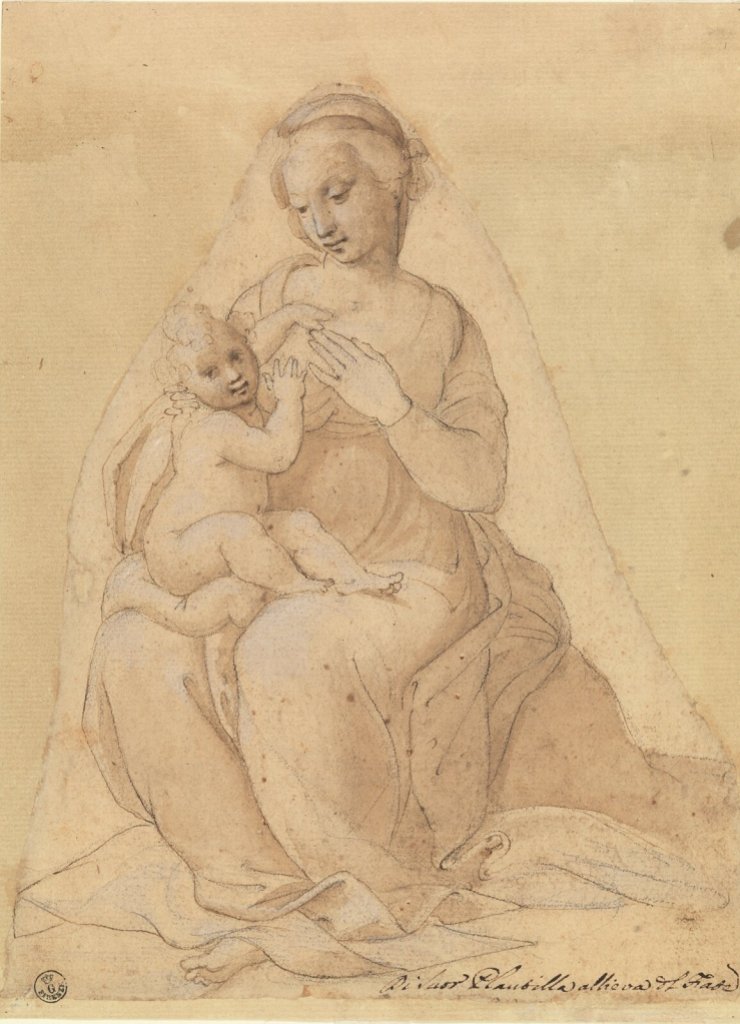
The expansion of the oeuvre associated with Plautilla – and the range of styles, genres and quality it now encompasses – raiseof her workshop and collaborators. The awareness of Plautilla’s assistants and collaborators goes back to the 16th century: while Vasari characterised Nelli as an isolated artist-nun, the Dominican author Serafino Razzi in his Storia degli uomini illustri (1596) named a number of other artists at Santa Caterina, either as ‘discepole’ of Suor Plautilla, or as painters and sculptors in their own right. Razzi must have been well informed, since his list included his own sister, Suor Maria Angelica Razzi, as well as Suor Agata Trabellesi, a nun from an established family of artists who seems to have carried the painting workshop at Santa Caterina forward as ‘madre pittora’ into the 17th century. Turrill Lupi has long cautioned against the romanticised notion – indebted to Vasari – of Plautilla as a solitary figure and highlighted how the surviving archival records from Santa Caterina allow us to trace the nuns named by Razzi and to appreciate how important the production of art was for the convent’s devotional and economic needs. The newly discovered devotional panels of the Virgin and Child provide a sense of what a large-scale production of devotional images by a collective workshop at the convent in the mid to late 16th century might have looked like. Much remains unknown, such as the activity of Suor Dionisia Niccolini, who Razzi listed as a sculptor specialising in terracotta. Tracing surviving works by these women is a formidable challenge, as even Plautilla seems to have only signed her very largest works: on the Last Supper she addressed her fellow nuns in the refectory at Santa Caterina to ‘pray for the painter’ (‘Orate pro pictora’: adapting a formula used earlier by Fra Bartolommeo, but transposing the Latin for ‘painter’ into the feminine).
After a quarter century of research, Plautilla’s quincentenary year sees the painter firmly established within in a canon of female artists, but, as Turrill Lupi remarks in the conclusion to her June lecture, the task remains to recover the other nun-artists Nelli trained, collaborated with and inspired at Santa Caterina. The unlikely context of the Dominican nunnery has emerged as the most fruitful setting for female artistic endeavour in Renaissance Tuscany (in contrast to, say, contemporary Bologna, where the professional opportunities for women artists seem to have been greater). It is perhaps fitting that Nelli’s anniversary followed on the heels of the 2023 exhibition at the Biblioteca Statale in Lucca dedicated to another Dominican nun-artist, Suor Eufrasia Burlamacchi (1482–1548), renowned in her day as a manuscript illuminator. Eufrasia’s convent of San Domenico in Lucca belonged to the same network of Tuscan Dominican nunneries as Santa Caterina in Florence, and Nelli must have known of Burlamacchi and her work.
Crucifixion (c. 1523), Suor Eufrasia Burlamacchi. Biblioteca Statale Statale di Lucca. Photo: Suri Li
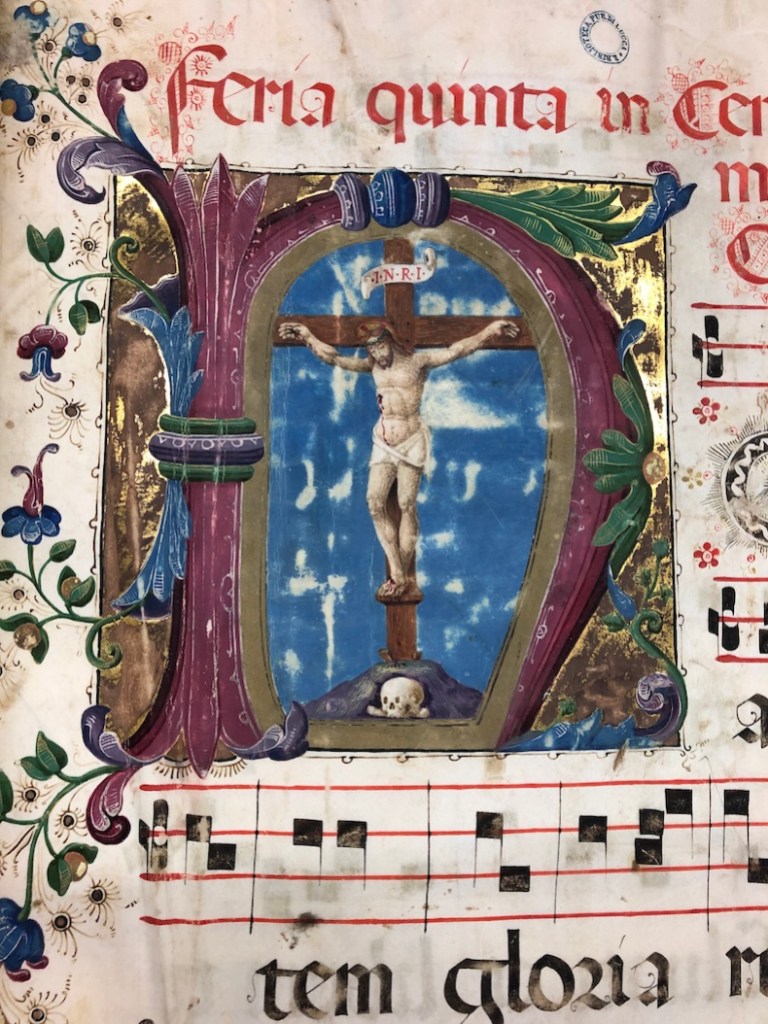
As well as consolidating Nelli’s own reputation, the quincentenary celebrations will surely encourage further research on other nun-artists active across Renaissance Tuscany, and especially those in the Dominican nunneries founded in the wake of Savonarola’s programme of reform – a movement which stressed the spiritual benefits of making and viewing devotionally appropriate art at the same time as consigning inappropriate imagery to the bonfires of the vanities. Given what we know of her dedication to her order and her convent, one suspects that Suor Plautilla would approve.
